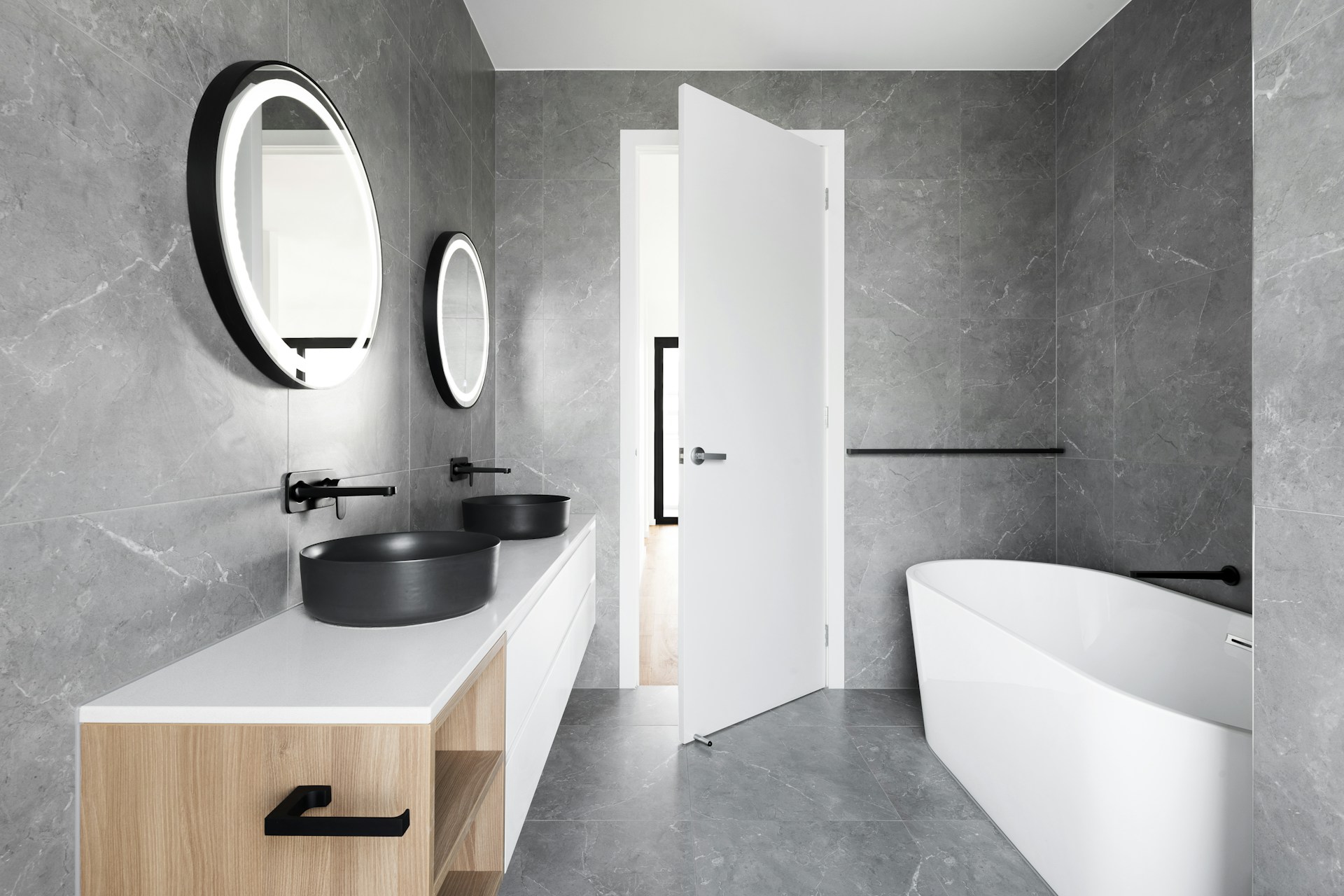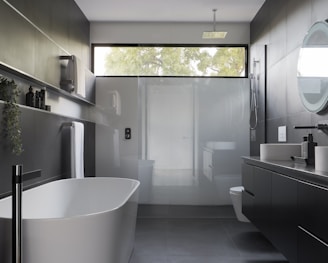
Bathroom Remodelling 101: Design Trends, Materials,
and Layouts to Consider
By Amanda Eleter
Planning Your Bathroom Remodel
Bathroom remodelling is a significant undertaking that can greatly enhance your home's functionality, aesthetics, and overall value. Often considered one of the most important rooms in a house, a well-designed bathroom can provide a personal retreat for relaxation and rejuvenation. Whether you want to create a modern, minimalist space, a luxurious spa-like retreat, or a charming vintage-inspired bathroom, a thoughtful renovation can transform your bathroom into a space that meets your needs and reflects your style.
In this comprehensive guide, we will explore various aspects of bathroom remodelling, including the latest design trends, essential materials, and optimal layouts. By the end of this article, you will clearly understand how to plan your renovation, choose the right elements, and execute a design that maximises both form and function.


Assessing Your Needs and Budget
The first step in any bathroom remodel is to assess your needs and set a realistic budget. Start by identifying the primary goals of your renovation. Are you looking to improve the space's functionality, update outdated fixtures, increase storage, or refresh the aesthetic? Understanding your priorities will help guide your decisions throughout the project.
Next, establish a budget that aligns with your goals. Consider all potential costs, including materials, labour, permits, and unexpected expenses. It’s advisable to allocate a contingency fund for unforeseen budget issues. A clear financial plan will prevent overspending and ensure you can complete the project as envisioned.
Creating a Timeline
A well-structured timeline is essential for keeping your bathroom remodel on track. Break down the project into phases, from initial planning to final touches. Here’s a suggested timeline for a typical bathroom renovation:
Planning and Design (2-4 weeks): Define your goals, set a budget, and create a design plan. Select materials, fixtures, and finishes.
Permits and Approvals (1-3 weeks): Obtain necessary permits and approvals from local authorities.
Demolition (1 week): Remove old fixtures, tiles, and any other elements that will be replaced.
Plumbing and Electrical Work (1-2 weeks): Install or update plumbing and electrical systems.
Flooring and Wall Installation (1-2 weeks): Lay new flooring and install wall tiles or other finishes.
Fixture Installation (1-2 weeks): Install new sinks, toilets, bathtubs, showers, and other fixtures.
Finishing Touches (1 week): Paint walls, install lighting, and add final decorative elements.
Final Inspection and Clean-Up (1 week): Conduct a thorough inspection to ensure everything is up to standard and clean the space.
Hiring Professionals vs. DIY
Deciding whether to hire professionals or undertake the project yourself is a critical decision in the remodelling process. Each option has its advantages and considerations:
Hiring Professionals: Engaging experienced contractors can ensure high-quality workmanship, adherence to building codes, and timely completion of the project. Professionals bring expertise and efficiency, which can be particularly beneficial for complex tasks such as plumbing, electrical work, and tile installation. While hiring professionals involves a higher upfront cost, it often results in a more polished and durable finish.
DIY: If you have the necessary skills and experience, a DIY approach can save money and provide a sense of accomplishment. DIY projects are best suited for less complex tasks like painting, installing fixtures, and minor tile work. However, it’s essential to be realistic about your capabilities and the time commitment required. Mistakes in DIY projects can lead to costly repairs and delays.


Current Design Trends
Clean lines and uncluttered spaces
Modern minimalism is characterized by its simplicity and functionality. This design trend focuses on clean lines, with furniture and architectural elements that emphasize geometric shapes and an uncluttered aesthetic. Spaces are open and airy, often featuring large windows that allow natural light to flood in, enhancing the sense of spaciousness. Furniture pieces are streamlined and functional, with an emphasis on quality over quantity. The goal is to create a calm, serene environment free from excess and distraction, where every element serves a purpose.
Neutral color palettes
The color palette in modern minimalism is typically neutral, featuring shades of white, black, gray, and beige. These colors create a timeless backdrop that can easily be adapted to different tastes and trends over time. Accents of natural materials, such as wood and stone, add warmth and texture to the space without overwhelming the overall aesthetic. Occasional pops of color, often in the form of art pieces or decorative accessories, can add interest and personality without disrupting the minimalist harmony.


Spa-Like Retreats
Incorporating luxurious elements
Spa-like retreats in home design focus on creating spaces that offer a sense of luxury and indulgence. This trend incorporates high-end materials such as marble, high-quality ceramics, and plush textiles to evoke the feeling of a high-end spa. Features such as large soaking tubs, rain showers, and underfloor heating contribute to a sense of opulence. Soft, ambient lighting, often provided by dimmable fixtures and strategically placed candles, enhances the relaxing atmosphere.
Creating a relaxing atmosphere
The primary goal of spa-like retreats is to create a sanctuary within the home where one can unwind and de-stress. This is achieved through careful attention to detail and a focus on comfort. Soft, soothing colors like pale blues, greens, and earthy tones are commonly used to promote relaxation. Natural elements, such as indoor plants and water features, are integrated to bring a sense of tranquility and connection to nature. The overall design emphasizes comfort, calm, and a break from the fast-paced world outside.
Vintage Revival
Classic fixtures and retro designs
Vintage revival is all about bringing back the charm and character of past eras into modern homes. This trend incorporates classic fixtures such as clawfoot tubs, pedestal sinks, and ornate lighting fixtures that harken back to earlier times. Retro designs, including mid-century modern furniture and decor, add a nostalgic touch while remaining stylish and functional. The use of patterns and motifs from the past, such as geometric prints and floral wallpapers, helps to create a distinctive look that is both timeless and contemporary.
Blending old and new elements
A key aspect of vintage revival is the seamless blending of old and new elements. This approach allows homeowners to enjoy the best of both worlds: the charm and history of vintage pieces combined with the convenience and innovation of modern design. For example, a vintage dining table might be paired with contemporary chairs, or an antique dresser might be used in a room with modern lighting and technology. This eclectic mix creates a unique and personalized space that reflects individual taste and a respect for the past, all while maintaining modern functionality and comfort.
Choosing the Right Materials
Regarding bathroom remodelling, selecting suitable materials is crucial for achieving a functional, aesthetically pleasing, and long-lasting space. From flooring to wall coverings and fixtures, each material choice significantly affects your new bathroom's overall look, feel, and durability.
Flooring Options
The flooring you choose for your bathroom should be both practical and visually appealing. Here are some popular options to consider:
Tile (ceramic, porcelain, stone)
Tile is a classic choice for bathroom floors due to its water-resistant properties and wide range of styles and colours. Ceramic and porcelain tiles are affordable and durable, while natural stone tiles like marble, granite, or slate offer a luxurious touch. However, stone tiles can be more expensive and may require additional maintenance.
Vinyl and laminate
Vinyl and laminate flooring are budget-friendly alternatives that mimic the look of tile or hardwood. They are water-resistant, easy to clean, and provide a warm, comfortable surface underfoot. However, they may not be as durable as tiles in high-traffic areas.
Wall Materials
The walls in your bathroom serve a functional purpose and contribute to the overall aesthetic. Here are some popular wall material options:
Paint vs. wallpaper
Paint is a classic choice for bathroom walls, offering various colours and finishes. Semi-gloss or high-gloss paints are recommended for their moisture-resistant properties. Wallpaper, on the other hand, can add texture and pattern to your bathroom, but it may not be as moisture-resistant as paint.
Tile backsplashes and accents
Tile backsplashes and accent walls can add visual interest and protection against water damage. Ceramic, porcelain, or glass tiles are popular choices for their durability and versatility in design.
Fixtures and Hardware
The fixtures and hardware you choose for your bathroom can significantly impact the functionality and the overall aesthetic. Here are some considerations:
Faucets, showerheads, and handles
Faucets, showerheads, and handles come in various styles, finishes, and price points. Consider the overall design aesthetic you want to achieve and your bathroom's water pressure and flow rate requirements.
Material choices (brass, chrome, matte black)
The material you choose for your fixtures and hardware can significantly influence the look and feel of your bathroom. Brass and chrome are classic choices, while matte black and brushed nickel offer a more modern and industrial vibe. Consider the durability and maintenance requirements of each material as well.
Optimal Layouts
In addition to material choices, the layout and design of your bathroom play a crucial role in creating a functional and comfortable space. Here are some considerations for optimal bathroom layouts:
Small Bathroom Solutions
Maximizing space and efficiency is key if you're working with a compact bathroom. Here are some strategies to consider:
Space-saving fixtures
To create the illusion of more space, opt for space-saving fixtures like pedestal sinks, corner showers, or wall-mounted toilets.
Creative storage options
Incorporate built-in shelving, recessed niches, or over-the-toilet cabinets to maximize storage without compromising floor space.
Main Bathroom Layouts
For larger master bathrooms, you can create a luxurious and functional retreat. Here are some popular layout options:
Separate shower and tub
Consider separating the shower and bathtub areas for added convenience and privacy. This layout also allows for more spacious and customized shower and tub designs.
Double vanities
Double vanities provide ample counter space and separate grooming areas for couples or families, reducing morning rush-hour congestion.
Universal Design Principles
Incorporating universal design principles into your bathroom remodel can ensure accessibility and future-proof your space. Here are some considerations:
Accessibility features
Install features like curbless showers, grab bars, and adjustable shower heads to accommodate individuals with mobility challenges or aging in place.
Future-proofing your bathroom
Consider wider doorways, open floor plans, and reinforced walls for potential future modifications, such as installing a walk-in tub or wheelchair accessibility. By carefully considering materials, layouts, and design principles, you can create a bathroom that meets your current needs and stands the test of time in terms of functionality, style, and accessibility.








